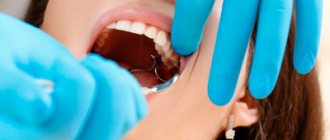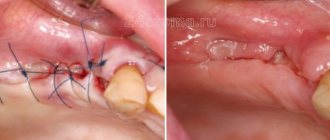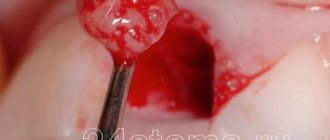Modern people have a fast pace of life, everyone has a lot of things to do, meetings, and obligations. Therefore, most of us tend to ignore minor symptoms such as an aching tooth, pain when biting, or reddening of the gums. As a result: tooth inflammation, pain, discomfort, postponed meetings and rescheduled plans.
Symptoms of tooth inflammation
Inflammation is the body's response to bacterial attack. Tissues begin to produce immune cells, signaling the hematopoietic organs that more white blood cells are needed. As a result, the vessels dilate, and the place where the microbes have penetrated swells and turns red. Nerve endings connect the pain syndrome so that we react as quickly as possible.
Main features
- Pain
In each case it can manifest itself differently. Sometimes it is pain when biting, sometimes it is continuous. It may get worse at night and subside with meals. It can radiate to the temple, ear, even nose. Being whiny or harsh.
- Redness
It may or may not be visible. This is a symptom that is more often detected by a doctor.
- Edema
Any inflammation is accompanied by swelling, but we cannot always determine this.
- Temperature increase
This doesn’t always happen, but fever is a sign of inflammation, so in this case you definitely shouldn’t put off going to the dentist.
- Tumor
This is also a dangerous signal; you need to see a doctor urgently.
If a tooth is inflamed and hurts, temporary measures will not help; you need a full diagnosis and treatment in a clinic. The alternative is tooth loss due to an advanced process.
Treatment
When the pain can no longer be tolerated and medications do not help, you should immediately visit the dentist. When examining the patient, the doctor prescribes the necessary treatment, which will not be quick, but will lead to a complete recovery. The main goal of any dentist is to save the tooth.
During the initial examination, an x-ray is taken, with its help you can see the most complete picture of the disease. When the source of inflammation is found, you can begin to determine the form of the disease and treat the root. Today in dentistry, anesthesia is used not only for tooth extraction, as it was in Soviet times; modern drugs are mostly hypoallergenic, non-addictive, do not have a large list of contraindications, and can also be used in the treatment of children's teeth.
When treating a tooth root, the doctor ensures maximum comfort for the patient, anesthetizes the treatment site, then opens the tooth root and cleans it of purulent accumulation, then a special medicinal mixture is placed into the hole. Having covered the top with a special gasket, the doctor closes the tooth with a temporary filling.
Next, you need to wait a few days for the inflammation to subside. You need to wait about 5-7 days and take another picture to confirm that the inflammatory process has stopped. Next, the cleaned dental canals are re-filled and a new temporary filling is installed. Filling protects against new infections, which contribute to inflammation.
After three days, a final follow-up visit is made to the doctor, who, after examining the patient, making sure that there are no inflammatory processes and successful treatment, closes the tooth with a permanent filling and polishes it.
Subsequently, a restoration process occurs, during which the gums may still be sore, the tooth may even become loose, but after a while, the unpleasant symptoms will disappear. To avoid recurrent disease of the root of the treated tooth, the doctor’s appointment is repeated six months later.
Causes
Accurate diagnosis is important for a positive treatment outcome. It is this that allows you to determine why the tooth is inflamed. There are 3 diseases hidden under the general term.
Pulpitis
Microbes penetrate through the dentin layer to the neurovascular bundle - the pulp. People call it a nerve. Usually, this happens with deep caries. The pulp is penetrated by nerve endings. The pain is often acute and difficult to endure. But sometimes it is not strong, periodic. We ignore it and the inflammation becomes chronic, destroying the pulp. A small bun makes a huge difference:
- produces secondary dentin, therefore, although the height of the teeth changes throughout life, they do not disappear completely;
- participates in tissue metabolic processes;
- conducts nerve impulses.
When the pulp dies, the tooth is said to become “dead.” Such teeth are quickly destroyed.
To treat pulpitis in dentistry, therapeutic and surgical methods are used. In the first case, medications are placed into the tooth cavity and closed with a temporary filling. After some time, the tampon with the medicine is removed and the tooth is filled. This method does not always help relieve inflammation inside the tooth.
If the process has gone far, the pulp or part of it is removed and then a permanent filling is placed.
Periodontitis
Under the crown of the tooth there is connective tissue - periodontium. As a result of injury or poor treatment, microbes penetrate there, causing inflammation of the tooth root - periodontitis.
.
There is an apical form, when only the apex is affected, and a marginal form, when all the tissue around the root is infected.
Symptoms of periodontitis:
- pain while eating or when jaws touch;
- feeling that the tooth stands out from the row (has become taller);
- temperature increase;
- tissue redness;
- tooth mobility;
- discharge of pus.
Periodontitis is an insidious enemy. Often the disease occurs without symptoms. It can only be suspected when the signs of the disease become pronounced: roots are exposed, gums bleed, pus is released, bone tissue decreases.
Treatment depends on the type of periodontitis and severity:
- Therapeutic method
The doctor opens access to the root canals, removes part or all of the pulp, and installs drainage to drain the pus. After a few days, the drainage is removed, the canals and tooth are processed and filled. It is recommended to place a crown on such a tooth.
- Surgical method
They resort to it if fibrosis has developed or there are granulomas.
Dentist:
- Cuts off the root tip
- Removes 1 root in multi-rooted teeth
- Amputates the root but leaves the crown intact
- Removes a tooth
- Performs separation (cuts the tooth in half, cleans it and puts it back together)
A course of antimicrobial tablets helps relieve inflammation inside the tooth.
Periodontitis
Periodontium is the fibers that hold the tooth in its socket. Plaque allows bacteria from it to penetrate into the periodontium and begin to rapidly multiply, forming a periodontal pocket. From the pocket, it is easy for them to get under the crown of the tooth and cause an inflammatory process there.
Before treating tooth inflammation under the crown, periodontal pockets are curetted, freeing the surface from tartar and plaque. Then they begin other manipulations: getting rid of caries, splinting teeth. Often, for periodontitis, a course of antibiotics is prescribed. The inflammation must be stopped so that the tooth does not have to be removed.
How to rinse your mouth after tooth extraction -
The most important rule is that you should never make intense rinsing movements. The fact is that immediately after tooth extraction, the socket is filled with blood, which normally coagulates almost immediately, forming a blood clot (Fig. 1-2). The blood clot also performs a protective function, preventing bacteria and food debris from entering deep into the wound. During the first few days, the clot is quite weakly attached to the bone walls of the socket, and therefore, if you rinse your mouth vigorously, the clot may fall out.
The loss of a blood clot from the socket will lead to bacteria and food debris getting deep into the socket. As a result, inflammation of the socket of the extracted tooth will occur, which dentists call “alveolitis.” Therefore, the right thing to do is either weak rinses (without active movements), or generally only antiseptic baths. The latter is that you must draw an antiseptic solution into the oral cavity, hold it for 30-60 seconds (without rinsing) and then spit it out.
What does the socket of an extracted tooth look like?
Thus, on the one hand, antiseptic rinses of the mouth after tooth extraction help prevent inflammatory complications (for example, suppuration of a blood clot and the development of alveolitis of the socket). Suppuration of a blood clot is possible in the following cases - 1) if the tooth was removed due to inflammation, 2) after a complex tooth extraction, 3) if there is a lot of soft microbial plaque, hard dental plaque or untreated carious teeth in the oral cavity.
In all these cases, antiseptic rinses (sometimes prescribed in combination with antibiotics) help prevent suppuration of the blood clot and the development of alveolitis in the socket of the extracted tooth. But on the other hand, if rinsing is carried out incorrectly, then, on the contrary, this can lead to the development of inflammation of the socket of the extracted tooth. Below you can see one of the options of what inflammation of the socket of an extracted tooth may look like (24stoma.ru).
Alveolitis of the socket of an extracted tooth –
If you look at Fig. 3-4, you will notice that in the depths of the socket traces of necrotic disintegration of a blood clot and food debris are visible, and the bone walls of the socket are exposed. Accumulations of microbial plaque are visible on the teeth. Typically, such inflammation of the socket is accompanied by an unpleasant odor from the mouth, and swelling of the gums may appear. The pain can be from moderate to very severe, and it tends to increase when hot or cold water enters the hole. Let's now figure out what to rinse your mouth after tooth extraction.
What is dangerous about severe inflammation of tooth tissue?
If measures are not taken in time, the inflammatory process can lead to:
- to the formation of granulomas, cysts, abscesses;
- pulp death;
- loosening of teeth;
- removal or loss of teeth;
- spread of infection to the jaw bone (flux);
- development of general diseases, including myocardial infarction.
It is very important to start treating tooth inflammation on time, and even better, to prevent it. Many clinics provide services for the treatment of dental inflammation. It is worth choosing one that has gained a lot of experience, has its own diagnostic base, and provides guarantees for the doctor’s work.
What to do if a tooth becomes inflamed?
It is clear that it is better to consult a dentist. What if the doctor is far away, you are at the dacha, it’s night and there is no one to leave the children with? You can try to relieve the pain yourself, using what you have at hand. The World Wide Web is full of tips on how to relieve tooth inflammation at home.
Folk remedies recommend:
- Gargling with herbal decoctions. Sage, chamomile, calendula are suitable. It is important that the broth is not too hot or cold. The optimal temperature is 50-60 degrees.
- Applications from clove oil, eucalyptus, propolis tincture. Be careful with tinctures, alcohol can burn the mucous membranes.
- Solutions of salt and soda help wash away food debris and relieve irritation. A drop of iodine in the solution will perform a disinfecting function.
If there are no herbs and it is unclear what to rinse with, there is a modern life hack. Mouthwashes contain antimicrobial agents and herbal extracts. They will cope no worse than infusions and decoctions.
Important! A sick tooth should not be heated. Avoid heating pads, bags of hot sand, and salt.
But a cold compress can relieve swelling and reduce discomfort.
If you have painkillers in your medicine cabinet, don’t delay taking them. The pain is exhausting and makes it difficult to concentrate. It’s better to relieve the pain and think about the next steps.
Remember, taking a pill does not fix the problem. Knowing how to relieve pain is useful, but only a qualified dentist can find the cause and eliminate it.
What to do in the morning
When the long-awaited morning arrives or you return from a trip, you need to immediately contact a good dental clinic. For example, come to us, at the Lucky Smile clinic, from 10 am to 10 pm, any day of the week. After this, your diseased teeth will be in the hands of our caring and attentive doctors.
They have all the necessary skills and knowledge to relieve you of toothache as quickly as possible and with the least damage. Specific actions will be developed for each case individually, but we can promise one thing in advance: the doctor will be able to relieve you of painful sensations on your first visit.










